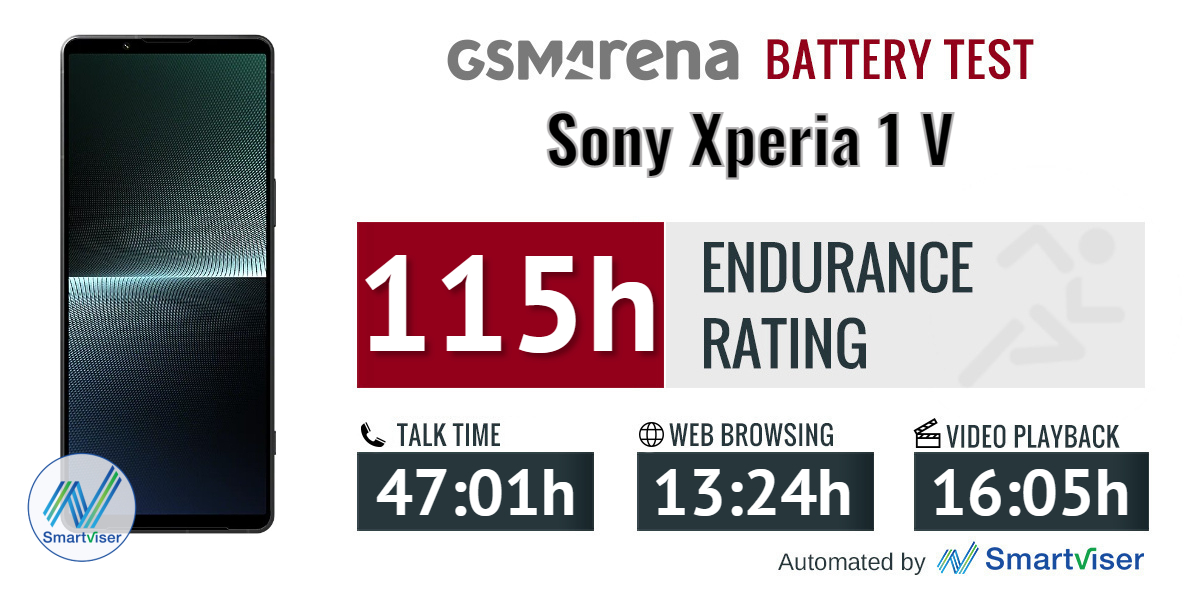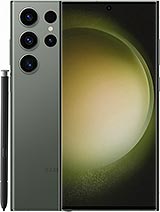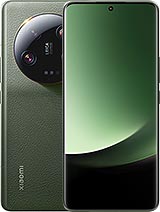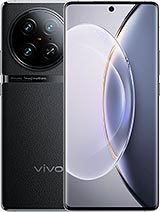Introduction
There are many flagship phones to choose from nowadays, but there is just one made for both casual and professional photographers. It's the one with a timeless design with excellent grip, top-notch cameras with a hardware shutter key, a 4K display, and front-facing stereo speakers. Yes, it's a Sony Xperia 1, the fifth of its line.
The Sony Xperia 1 V is an incremental upgrade over the Xperia 1 IV, but given how good that one was, there is no surprise. Still, the 1 V brings the latest Snapdragon 8 Gen 2, now with a better cooling system and a promise for less throttling and no overheating. There is an improved primary camera with a multi-aspect 52MP sensor, plus, drum rolls, Night mode is now available!

The design has been thoughtfully improved, and you are looking at the only non-rugged smartphone that deserves a Perfect mark for grip. The Xperia 1 V has two Gorilla Glass Victus panels, and the rear one is matte with a dotted pattern for extra grip. The metal frame is all ridged, too, and this is how a premium phone can provide an outstanding grip experience without giving up on looks.
The 4K OLED display is here to stay, and so are the front-facing stereo speakers - now featuring an improved amplifier for richer sound. The lovely haptic feedback the Xperias are known for is available, too.
Let's talk about the camera. The primary imager got a massive update with a multi-aspect 52MP Sony sensor with an effective 48MP resolution. Thanks to the new stacked architecture, it should offer the noise performance and the dynamic range of a full-frame camera (in the dark), according to Sony.

The rest of the cameras remain the same as on the Xperia 1 V - a 12MP telephoto with a 3.5x-5.2x continuous optical zoom, a 12MP ultrawide-angle with autofocus, and a 12MP selfie camera with a fixed focus. All rear cameras support 4K120 capturing, while the front one maxes out at 4K60.
The Sony Xperia 1 V is powered by a 5,000mAh battery, and it supports 30W wired charging, plus both wireless and reverse wireless charging. The phone runs on Android 13 with Xperia UI.
And here are the complete specs.
Sony Xperia 1 V specs at a glance:
- Body: 165.0x71.0x8.3mm, 187g; Glass front (Gorilla Glass Victus 2), glass back (Gorilla Glass Victus), aluminum frame; IP65/IP68 dust/water resistant (up to 1.5m for 30 min).
- Display: 6.50" OLED, 1B colors, 120Hz, HDR BT.2020, 1644x3840px resolution, 21:9 aspect ratio, 643ppi; Runs at 1096 x 2560 pixels except for select use cases.
- Chipset: Qualcomm Snapdragon 8 Gen 2 (4 nm): Octa-core (1x3.2 GHz Cortex-X3 & 2x2.8 GHz Cortex-A715 & 2x2.8GHz Cortex-A710 & 3x2.0 GHz Cortex-A510); Adreno 740.
- Memory: 256GB 12GB RAM; UFS 4,0; microSDXC (uses shared SIM slot).
- OS/Software: Android 13, Xperia UI.
- Rear camera: Wide (main): 52 MP, f/1.9, 24mm, 1/1.35", 1.12µm, Dual Pixel PDAF, OIS; Telephoto: 12 MP, f/2.3, 85mm, f/2.8, 125mm, 1/3.5", Dual Pixel PDAF, 3.5x-5.2x continuous optical zoom, OIS; Ultra wide angle: 12 MP, f/2.2, 124˚, 16mm, 1/2.5", Dual Pixel PDAF.
- Front camera: 12 MP, f/2.0, 24mm (wide), 1/2.9", 1.25µm.
- Video capture: Rear camera: 4K@24/25/30/60/120fps HDR, 1080p@30/60/120fps; 5-axis gyro-EIS, OIS; Front camera: 4K@30fps, 1080p@30/60fps, 5-axis gyro-EIS.
- Battery: 5000mAh; 30W wired, PD3.0, PPS, 50% in 30 min (advertised), Wireless, Reverse wireless.
- Connectivity: Dual SIM 5G; eSIM; Wi-Fi 6; BT 5.3, aptX HD, aptX Adaptive; NFC; 3.5mm jack.
- Misc: Fingerprint reader (side-mounted); front-facing stereo speakers; Native Sony Alpha camera support (Creator app).
We are thrilled to see that Sony is keeping alive the microSD expansion and the 3.5mm audio jack, and we love its persistence in having notch-free screens. The symmetrical front speakers are a Sony trademark, too, one that we are quite fond of.
There is one thing that has been retired on the Xperia 1 V is the tiny notification LED. We suspect that Sony still cannot offer dynamic refresh rate, which is essential for better battery life, but we will talk about that in a bit.
Now, without further ado, let's meet the Sony Xperia 1 V.
Unboxing the Sony Xperia 1 V
The Sony Xperia 1 V ships in a small and thin box made of recycled paper. Inside you will find the Xperia itself and, well, nothing else.

Sony offers neither a charger, nor a cable. And if you want the best charger (and cable) for your new Xperia 1 V, you will have to buy Sony's 30W XQZ-UC1 charger bundle for €50 or so.
Design, build quality, handling
The Sony Xperia 1 V is all about camera experience, that is for sure, and it nails the one thing the majority of cameraphones fail - having a top-notch design with superb grip experience.

Indeed, having a proper grip for a cameraphone is a thing few understand, and we are glad that Sony is improving it with each year. But the design language remains the same - simple, classic, timeless.
The Sony Xperia 1 V keeps the Xperia signature look - it has two Gorilla Glass Victus flat panels (Victus 2 front and Victus 1 rear) and a solid metal chassis in between. The Victus panels are not the only protection you get, of course, as the Sony Xperia 1 V is also IP65/IP68 certified for both water jets and clean water submersion - just like many of the previous models.

There are two major improvements in the design of the Xperia 1 V since the previous model.
The first notable change is the back panel - it is completely matte, as before, but now it also has this tactile blister texture - thousands of tiny humps spread as a barely visible mesh. The pattern is reminiscent of the grip on the Sony's Alpha ZV-E10 camera. And the Xperia 1 V grip is incredible, and the whole thing is completely smudge-proof. How about that?

Then comes the frame, borrowed straight from the Xperia Pro-I - this means it is made of metal and has a unique riged pattern that makes for a firm grip and extra comfort. And let's not forget the two-step hardware shutter key, with the same grippy finish as the back panel.

The triple camera is one of the two centerpieces of the Xperia 1 V. It's a small island made of metal that houses the entire camera kit (12MP ultrawide, 52MP primary, 12MP telephoto). You can spot the LED flash and the microphone for voice enhancement here, as well as the Zeiss - logo. The housing is jutting out a bit of the back, but the wobbling of the Xperia 1 V is minimal, which is commendable.
The other centerpiece is the notch-free 6.5-inch 4K OLED screen at the front. The top and bottom bezels are hardly eyesores. In fact, not having a cutout is a sight for sore eyes, and we do love it.

Each of the bezels has a long and thin speaker outlet. The top one also packs a 12MP selfie camera and a bunch of sensors.

Let's explore the sides of the Xperia 1 V now.
There is nothing on the left but endless stripes.
The right one has the volume control, the power/lock key, and the two-step shutter key. The power key's surface accommodates the always-on fingerprint reader. It is blazing-fast and nicely reliable, and you can change its scanning trigger from Touch to Press like on many other phones.

The top of the Xperia 1 V has a 3.5mm audio jack and another microphone.

The bottom houses the primary microphone, the USB-C port, and the hybrid-SIM card tray. The latter doesn't need a pin to eject (another Xperia perk) - you can pop it with the tip of your fingernail. The tray can either take two nano-SIM cards, or you can use the second bed for a microSD card instead.

The Xperia 1 V measures 165.0x71.0x8.3mm and weighs 187 grams - about the same as the 1 IV. This makes it one of the most compact, lightweight and yet solid smartphones on the market.
The timeless Xperia design remains a lovely classic that has its spot on the market, too, and doesn't feel dated. On the contrary, the Sony Xperia 1 V is probably one of the few phones to be equally presentable for both casual and very formal events. It is available in Black, Khaki Green and Platinum Silver.

Furthermore, the Xperia 1 V is a pleasure to work with - it has a compact and lightweight body, very well protected, with the best grip we've experienced on a non-rugged smartphone. If we had to rate its design and grip, it would have been the only phone to get 10 out of 10.

Long story short, the Sony Xperia 1 V is currently the best smartphone on the market as far as design, build and handling are concerned. No other than Sony can offer such a thoughtful build and yet compromise nothing while achieving it. Great job, Sony!
Unique 4K 120Hz HDR10 OLED panel
The Sony Xperia 1 V relies on a display we've already experienced on the Xperia 1 IV, 1 III and Pro-I, one that still feels ahead of its time. The 6.5-inch OLED panel on the Xperia 1 V has a 4K resolution in 21:9 aspect ratio, 3,840 x 1,644 px or 643ppi to be specific. And, of course, it's a screen without any cutouts!

Just like on the previous models, the 4K resolution is not always active - that would be both a battery and app compatibility nightmare. Instead, the Xperia 1 V is rendering most of the content at extended Full HD resolution (2,560 x 1,096 px). The full 4K resolution is used primarily in multimedia apps such as Photos and video playback/streaming across different services.
The OLED panel supports 10-bit color depth and a wide color gamut. It is also HDR10 certified.
The screen also supports a 120Hz refresh rate, but it doesn't go easy on the battery. When enabled, the phone uses 120Hz most of the time and reverts back to 60Hz only for video playback and incompatible apps (liek the camera apps, Google Maps, etc.).
We've completed our display tests, and the numbers are great.
The screen can be as bright as 866 nits with the sunlight auto brightness boost, or about 590 nits when manually controlling the brightness.
The Creator mode allows for a minor brightness boost, specifically in the default (Medium) White Balance option. Here we captured 936 nits of maximum automatic and 640 nits of maximum manual brightness.
The minimum brightness at point white was just 1.9 nit - an excellent one.
Color accuracy
The Xperia 1 V offers plenty of color settings.
The first one is 'Image quality' - it lets you pick between Creator and Standard modes, while further tweaking is possible in the 'White balance' section - options include Warm/Medium/Cool presets, custom color temperature, as well as RGB sliders for extra granular tweaking.
Creator mode is intended for 4K resolution in HDR with BT2020 color gamut with 10-bit color. This is the mode you should use when working with such content, and it will provide a faithful presentation of colors. And indeed, we captured great color accuracy here.



Display options • Image Quality • White Balance
Meanwhile, Standard mode (the out-of-the-box setting), delivers a punchier output that doesn't necessarily aim for accuracy. It is still fairly accurate, though the white and gray hues are bluish, and the blue colors are punchier. That is because the Standard Mode uses Cool white balance by default, changing it to Medium or Warm will remove the blue tinge.
There's an option for auto Creator mode engagement in Standard mode, so that phone can switch accordingly when presented with compatible content.
Refresh rate
There is only one refresh rate option - enabled or disabled. When active, the display will always use a 120Hz refresh rate, even when showing a static picture. The usual exceptions like Google Maps, video playback, and the camera viewfinder apply, of course.

Sony is way behind the competition when handling the refresh rate behavior, and we are sad to see it has passed yet another year without any sort of improvement.
But on a positive note, Sony has improved the Xperia 1 V thermals, and we no longer noticed display throttling as on the Xperia 1 IV. When 120Hz was selected, the screen remained at 120Hz even after long benchmark testing.
Game Enhancer
Games have their own way of handling the refresh rate. From the Game Enhancer app, you can switch the refresh rate for the display to 120Hz for titles that can go above 60fps - it's at 60Hz by default. You can also force it to 120Hz regardless of whether you know for a fact that the game itself supports a higher frame rate - just to be sure. That's done on a per-game basis.
While using Game Enhancer, you may notice there is a 240Hz option, too. Sony calls this blur reduction, and it uses frame interpolation to reduce blur when using 120Hz mode, and 120Hz is supported by the game.


Game Enhancer refresh rate settings
HDR and streaming
The Sony Xperia 1 V OLED has the ideal screen for movie streaming - 21:9 aspect ratio, 1B colors, HDR10, 4K resolution. Dolby Vision is not supported, unfortunately.
Netflix has yet to support the Xperia 1 V, and it offers 1080p SDR streaming, but don't forget the Xperia 1 V is not out for at least another month.
YouTube and Prime Video do recognize the screen as 4K HDR10 and offer streaming in such high-resolution.
Finally, there is this option in Image Quality Settings called Video Image Enhancement (X1 for Mobile). This is enabled by default, and it improves the quality of videos via Sony's proprietary X1 engine.
There is also support for a real-time HDR drive, which analyzes HDR videos frame by frame and applies the proper tone curve.
Haptic feedback
We just want to dedicate a few words to the screen's haptic feedback - it's one of the best we've used, with lovely haptics you can feel at the exact spot where you've tapped.
Dynamic Vibration is supported, too, which syncs with your audio/video, but we've never been fans of the feature.
Battery life
The Sony Xperia 1 V is powered by a 5,000mAh battery, just like the one inside the Xperia 1 IV.
The Sony Xperia 1 V aced our battery life test and posted an outstanding endurance rating of 115 hours. It did marvelously on the call, web and video tests.

Our battery tests were automated thanks to SmartViser, using its viSerDevice app. The endurance rating denotes how long the battery charge will last you if you use the device for an hour of telephony, web browsing, and video playback daily. More details can be found here.
The standby power consumption is on par with the previous Xperia 1 IV model - meaning quite frugal and above average performance.
Video test carried out in 60Hz refresh rate mode. Web browsing test done at the display's highest refresh rate whenever possible. Refer to the respective reviews for specifics. To adjust the endurance rating formula to match your own usage patterns check out our all-time battery test results chart where you can also find all phones we've tested.
Charging speed
The Sony Xperia 1 V supports 30W fast wired charging, and there is also support for wireless and reverse wireless charging.
The Xperia 1 V ships with no charger and no cable. If you don't own a Power Delivery charger, Sony will happily sell you its own 30W XQZ-UC1 PD charger/cable bundle. You can also get any third-party charger that supports at least 30W USB Power Delivery, of course.

Sony is advertising 50% charge in half an hour when using a compatible 30W power adapter.
We have completed our charging test with a 65W Baseus charger with a dedicated 30W USB-C port.
Starting from 0% the Xperia 1 V recharged up to 27% on the said charger. And we captured 50% charger on the 30 min mark, exactly as promised.
A full charge took 97 minutes, but you should know that the charging process slows significantly after the 80% marker (which took exactly 60 minutes to reach).
Sony is advertising the battery inside the Xperia 1 V as capable of lasting for three years in peak condition before you start seeing and feeling traces of deterioration in the battery life performance. This means it will retain above 80% of its usable capacity for those three years.
The Battery Care option as part of the Battery settings will allow you to further extend your battery lifespan. You can either rely on the Auto process or set the time and percentage charging limits by yourself.
And the Battery Share option is what enables reverse wireless charging. You can set % for the remaining charge and time limits here, too.
Speaker loudness and quality
Sony has been famous for its stereo speaker setups, and the Xperia 1 V brings one of those iconic front-facing combos just like the previous models. Those appear to be of equal size and of perfect balance.

There has been an improvement since the Xperia 1 IV - a new amplifier is at play here, and it should offer a fuller sound with more bass.
Let's talk about the audio options first.
The Xperia 1 V speakers support Dolby Atmos, and it makes for a bit louder and richer sound. We tested it both ways, and we can confirm the Dolby Atmos output is better, and you should keep this feature ON.
The Sony Xperia 1 V also supports 360 Reality Audio for immersive sound. It works with headphones; you can fully personalize your experience and manually pick the apps it should be working with.






Audio options • Dolby Atmos • Dolby Atmos • 360 Reality Audio
There are other cool options like DSEE Ultimate audio uplifting - this uses AI technology to upscale your compressed music. An intelligent wind filter for the microphones is available, too. And there is Spatial Audio support right out of the box.
We've completed our loudness test, and the Xperia 1 V speakers scored a Very Good mark (Good without Dolby Atmos). We can confirm the audio is nicely loud at 100%, and the sound is incredibly rich - from bass, voice, all the way to the higher frequencies. But don't just take our word for it; grab a pair of headphones and listen to the sample below.
Use the Playback controls to listen to the phone sample recordings (best use headphones). We measure the average loudness of the speakers in LUFS. A lower absolute value means a louder sound. A look at the frequency response chart will tell you how far off the ideal "0db" flat line is the reproduction of the bass, treble, and mid frequencies. You can add more phones to compare how they differ. The scores and ratings are not comparable with our older loudspeaker test. Learn more about how we test here.
Android 13 with clean Xperia UI
The Sony Xperia 1 V boots Android 13 skinned with the most recent version of the Xperia UI, which got a very stock Android feel, though there are in-house bits if you look deep enough.
Starting with some of the basics, there's an always-on display feature (AOD) that goes by Google's Ambient display name and has a fairly limited set of customization options.

The lockscreen is business as usual with a clock (that you can customize), a shortcut to the camera and another one for Google Assistant.




Always on display • Always on display • Always on display • Lockscreen
The homescreen, too, is as standard as they come. The Google feed is the leftmost pane, but you can disable it if it's not your thing. The quick toggles/notification area is Google's stock too. With this version of Android, you get Notification history, and the Bubbles shortcuts as part of the Conversations features - both available on the Xperia, unlike some more heavily customized UIs.






Homescreen • Folder view • App drawer • Notification shade • Quick toggles • Notification settings
The Android OS is highly customizable via the Wallpaper and Style menu. Here you can choose from a number of static and live wallpapers. A cool thing about the live option are the various effects that are applied to the wallpapers in real-time - for example, a cool disturbance during charging.
You can choose from the typical color palettes, depending on the wallpaper. You can customize them, too. And you can opt for Themed Icons - the system icons will match the color palette, but the feature is still in beta and may not always work as intended.






Wallpaper and style • Wallpaper and style • wallpapers • wallpapers • change system icons
This brings us to one of the Sony exclusives, which deserves a mention even though it's not new - Multi-window switch. You can access it from the task switcher or from the dedicated shortcut icon on the homescreen, and you get sort of like two stacked task switcher rolodexes with your currently opened apps to pick one for the top half and one for the bottom half of the screen. The rightmost pane in each half lets you launch another app, not just pick from the already running ones.

The phone remembers three previously used pairs, so you can access them directly. It's worth mentioning that the window split can be done in almost any arbitrary ratio, not just 50/50.



Task switcher • Multi-window switcher • Pop-up window
Side sense is another of the in-house Sony features. A handle on the side of the phone opens up a menu of shortcuts to apps and features, most of them user-configurable. The 21:9 multi-window pairs can be customized here, but they don't go into the three pair shortcuts in the regular task switcher. A recent addition to the menu is a widget to control the Sony headphones app - handy if you have a set of those.
There's a fairly standard set of gestures for call handling, as well as a one-handed mode and smart backlight control. It's in this menu that you'll find the navigation options with the two basic types available - gestures or a navbar.
Pros can enjoy the occasional game too, so the Xperia has Sony's Game Enhancer as part of its software package. It's a comprehensive utility with two main interfaces - a game hub/launcher, and an overlay you pull out from the side while in a game.
Performance profiles (or Game Mode) can be set on a per-game basis, and it's here that you get to set the screen refresh rate and lock it at 120Hz regardless of whether the game supports it (though you will still get 60fps if the game does not support HFR). Additional sliders let you select Touch response speed and touch tracking accuracy.
There is also a 240Hz setting, which inserts a black frame between each 120Hz frame. This reduces the blur, and Sony recommends using this option in games that support 120fps.
There is also H.S. power control - a setting that deals with power management. When the feature is enabled (look for it in Settings while in-game), and the phone is plugged in, it won't actually charge the battery but will only essentially meet your current power consumption so as to avoid unnecessary heat generation - H.S. stands for Heat Suppression.
The Focus setting is an array of toggles that let you disable pesky notifications, turn off adaptive brightness, disable the camera button and the side sense functionality - limit distractions.
There are also screenshot and video capture features.

The phone uses Google's own Photos and Files for gallery and file management purposes. It does come with Sony's own Music player, though.




Music • Music • Photos • Photos
Bravia Core has been exclusive to Bravia TVs up until this Xperia model. It offers a rich Sony Classics movie catalog, and you can also watch a few of the blockbuster titles for free on a trial basis. The service offers movies up to 4K60 quality, and some titles even have MAX enhanced audio. And the best part is that you get 1-year free access to Bravia Core with your new Xperia 5 IV.
Sony's Music Pro is a paid service that allows you to record singing and instruments and upload this recording to the cloud for processing. The audio will then get processed as if you've used a high-quality condenser mic in the acoustic environment of a professional studio. New for the Xperia 1 V is the support for piano and podcast types.
The Creators app that allows easy connection to Sony Alpha cameras is also available.
Performance and benchmarks
The Sony Xperia 1 V uses the latest Snapdragon 8 Gen 2 chipset, the mainstream version, not the one exclusive to Samsung. It is coupled with LPDDR5X RAM and UFS (probably 4.0) storage chips.
The Snapdragon 8 Gen 2 packs an octa-core processor with one prime core, four performance ones (2+2), and three efficient cores, a.k.a. 1+2+2+3 configuration. This means the CPU contains 1x3.2GHz Cortex-X3 + 2x2.8 GHz Cortex-A715 & 2x2.8GHz Cortex-A710 & 3x2.0GHz Cortex-A510 CPU cores.
Then there is the Adreno 740 GPU - the most capable mobile GPU on the market right now.
There is only one model of the Sony Xperia 1 V, and it packs 12GB RAM and 256GB storage. The phone offers microSD expansion, probably the only top-tier smartphone to do it.
And now, let's run some tests.

The Xperia 1 V and its Snapdragon 8 Gen 2 chipset do very well on the CPU tests, and you can tell the phone has the latest technology even if its scores didn't top the chart (still in the same ballpark as the rest of the SD8G2 devices).
GeekBench 5 (multi-core)
Higher is better
- Xiaomi 13 Ultra
5049 - Galaxy S23 Ultra
4927 - OnePlus 11
4899 - Oppo Find X6 Pro
4759 - Sony Xperia 1 V
4652 - vivo X90 Pro
4273 - Huawei P60 Pro (perf. mode)
4096 - OnePlus 11R 5G
3608 - Sony Xperia 5 IV
3448 - Sony Xperia 1 IV
3403
GeekBench 5 (single-core)
Higher is better
- Galaxy S23 Ultra
1537 - Xiaomi 13 Ultra
1477 - Sony Xperia 1 V
1459 - vivo X90 Pro
1387 - Huawei P60 Pro (perf. mode)
1313 - Sony Xperia 5 IV
1233 - Oppo Find X6 Pro
1166 - Sony Xperia 1 IV
1160 - OnePlus 11
1150 - OnePlus 11R 5G
1060
GeekBench 6 (multi-core)
Higher is better
- Xiaomi 13 Ultra
5556 - Oppo Find X6 Pro
5082 - Galaxy S23 Ultra
5077 - OnePlus 11
5043 - Sony Xperia 1 V
4916 - Huawei P60 Pro (perf. mode)
4422 - OnePlus 11R 5G
3913
GeekBench 6 (single-core)
Higher is better
- Xiaomi 13 Ultra
2000 - Sony Xperia 1 V
1956 - Galaxy S23 Ultra
1913 - Huawei P60 Pro (perf. mode)
1758 - Oppo Find X6 Pro
1532 - OnePlus 11
1527 - OnePlus 11R 5G
1399
The same goes for the GPU scores. Do bear in mind that the Xperia 1 V ran the GPU tests at 1,096 x 2,560 resolution, which gave it an edge over 1440p-packing devices like the Samsung and Xiaomi Ultra models.
GFX Aztek Vulkan High (onscreen)
Higher is better
- Sony Xperia 1 V
71 - vivo X90 Pro
68 - Galaxy S23 Ultra
60 - Oppo Find X6 Pro
56 - Xiaomi 13 Ultra
55 - Sony Xperia 5 IV
55 - OnePlus 11R 5G
54 - OnePlus 11
53 - Huawei P60 Pro (perf. mode)
51 - Sony Xperia 1 IV
31
GFX Aztek Vulkan High (offscreen 1440p)
Higher is better
- Xiaomi 13 Ultra
69 - Galaxy S23 Ultra
69 - Oppo Find X6 Pro
68 - OnePlus 11
68 - Sony Xperia 1 V
54 - vivo X90 Pro
54 - OnePlus 11R 5G
51 - Huawei P60 Pro (perf. mode)
48 - Sony Xperia 5 IV
38 - Sony Xperia 1 IV
26
GFX Car Chase ES 3.1 (onscreen)
Higher is better
- Sony Xperia 1 V
96 - Sony Xperia 1 IV
74 - vivo X90 Pro
74 - Galaxy S23 Ultra
67 - Huawei P60 Pro (perf. mode)
65 - Xiaomi 13 Ultra
63 - Sony Xperia 5 IV
63 - Oppo Find X6 Pro
60 - OnePlus 11R 5G
60 - OnePlus 11
57
GFX Car Chase ES 3.1 (offscreen 1080p)
Higher is better
- Xiaomi 13 Ultra
129 - Galaxy S23 Ultra
126 - Oppo Find X6 Pro
126 - OnePlus 11
126 - Sony Xperia 1 V
113 - vivo X90 Pro
105 - OnePlus 11R 5G
104 - Huawei P60 Pro (perf. mode)
101 - Sony Xperia 1 IV
79 - Sony Xperia 5 IV
70
The compound AnTuTu 9 tests puts the Xperia 1 V on par with the OnePlus 11 and close to the rest of the SD8G2 gang.
AnTuTu 9
Higher is better
- Oppo Find X6 Pro
1294797 - Xiaomi 13 Ultra
1268538 - Galaxy S23 Ultra
1241531 - vivo X90 Pro
1228735 - OnePlus 11
1140661 - Sony Xperia 1 V
1127931 - Huawei P60 Pro (perf. mode)
1031328 - OnePlus 11R 5G
953897 - Sony Xperia 1 IV
838832 - Sony Xperia 5 IV
835038
The Xperia 1 V features the latest Snapdragon 8 Gen 2 chipset by Qualcomm, par for the course for any self-respecting flagship.
The previous Sony Xperia models have been known for their notorious overheating and throttling, and not only for the chipset but for the display as well.
Sony claims it has worked on that, and the new Snapdragon chip, combined with an improved thermal sheet will offer reduced power consumption and better heat dissipation.
We have explored this extensively, and there is both good and bad news. Let's start with the bad one.
The CPU and GPU stress tests haven't improved since the Xperia 1 IV - that is the bad news. The Xperia 1 V scored 53% stability, which is not bad - you can see the CPU locked at about 60% performance after the first 15 or so minutes.
The GPU test is unimpressive with 45% stability - the throttling began after 6 minutes of running at peak GPU performance.
Now, the good news.
First, the Xperia 1 V never became hot, warm - yes, but never uncomfortably hot.
Second, there is no display throttling; the screen refresh rate remained at 120Hz even after prolonged benchmark testing.
And third, the most important news is no more camera overheating! It was incredibly awful for a cameraphone to overheat after just 5 minutes of 4K video recording (Xperia 1 IV, we're looking at you), but that's a thing of the past. The Xperia 1 V is not even warm after shooting for 30mins in 4K, which is excellent news.
The camera overheating warnings are still there in the menus for some features, but we never experienced them, and we hope you will never do, as well.
We played a game for half an hour, too, and the Xperia 1 V was not hot and did not throttle, not obviously, at least. That's why we think most gamers and photographers alike would be happy with the improved thermals even if this was not reflected in the synthetic tests.
ExmorT sensor premieres on Xperia 1 V
The Sony Xperia 1 V has a triple camera setup on the back that is similar to the one on the Xperia 1 IV - a wide-angle primary, an ultrawide-angle secondary, and an advanced telephoto camera with continuous optical zoom. The new selfie camera from the Xperia 1 IV also made it to the new model.
There is one big improvement on the Xperia 1 V - it's using the world's first stacked CMOS sensor with 2-layer transistor pixel technology.

The primary camera on the Sony Xperia 1 V introduces the Sony ExmorT IMX 888 sensor - it's a multi-aspect 1/1.35" imager with 52MP resolution (48MP effective), 1.12µm pixels, and it sits behind stabilized (OIS) 24mm f/1.9 lens.
The new sensor is 1.7x larger than the one on the Xperia 1 IV, but that's not what makes it special. It is an upgrade over the stacked structure of the ExmorRS generation (shipping in most of the current smartphones). The new ExmorT has the photodiodes and their corresponding transistors on two separate layers instead of sitting one next to the other in a conventional manner. While requiring micron-level alignment accuracy, it has also meant the photodiodes are now larger, collecting light twice as well and also up to three times higher saturation levels. The transistors sitting on a separate layer have also been given optimized, which has resulted in a cleaner signal with less noise.
The 4.3:3 multi-aspect sensor has a larger area than the mainstream 4:3 sensor, and this can be used to improve video stabilization.
The ultrawide camera is the same as on the Xperia 1 IV - it uses a 12MP Sony IMX 563 1/2.55" sensor with 1.4µm pixels sitting behind a 16mm f/2.2 lens. This camera also supports Dual Pixel AF.
The zoom camera is also identical to the one on the Xperia 1 IV. It relies on a 12MP Sony IMX650 1/3.5" sensor with 1.0µm pixels and PDAF. It has an innovative stabilized lens (OIS) that offers continuous optical zoom between 85mm f/2.3 (3.5x) and 125mm f/2.8 (5.2x) over the main camera. You can seamlessly zoom between these two levels.
There is no ToF camera on the Xperia 1 V, Sony says there is no need for such. The maker relies on AI-created depth information instead.

Finally, the selfie camera packs a 12MP Sony IMX 663 1/2.9" sensor with 1.µm pixels behind a 20mm f/2.0 lens and a fixed focus at infinity.
The Photo Pro and Video Pro apps now support vertical UI, which is a welcome addition!
There are a couple of new features on the Xperia 1 V. There is a new S-Cinetone picture profile for the Video Pro app, which has a moody look with enhanced skin tones and cinematic color. For someone who's not familiar with S-Log or color grading, it provides a nice default output.
And secondly, there is a new Product Showcase mode, borrowed from the Alpha cameras, which is aimed at product vloggers, and allows the camera to auto-focus on the product you are holding instead of your face.
Photo Pro (default app)
The default camera app on the Xperia 1 V is Sony's Photo Pro. Its Basic mode is where you'll spend most of your point-and-shooting time when you don't care much about creative control. There is one new feature here - Night View. It's either Auto or OFF, and it's basically the Night Mode we have been waiting for. According to Sony it's more conservative and triggers in darker environments than the competition. There is no indication in the camera's Basic mode if the Night View has triggered or not, but there is one in the Auto mode view.
The sliders for (implied) white balance and exposure compensation, bokeh mode, drive mode, flash and aspect ratio are placed immediately next to the shutter release. The zoom selector is nearby, too, so pretty much everything can be operated with a single thumb without having to use your other hand. And you can use either the hardware or the virtual shutter keys.

By the way, the Burst shooting has been increased from 24 to 30fps now.
At the opposite end of the viewfinder, and for these, you'll need your other hand, you'll find a More button, a shortcut to Google Lens, a Menu button to access the (rather lengthy) Settings menu, and the button that lets you switch between this Basic mode/app and its Pro alter ego.
When in the Pro section of Photography Pro, you get an Auto mode, as well as the classic Program, Shutter priority and Manual modes, plus a Memory Recall option where you can store a pre-set state of settings to be able to come back to quickly.
The Photo Pro interface is reminiscent of a dedicated Sony Alpha camera, only adapted for smartphone use. On the right, you get to change photographic settings like focus mode and area, white balance and ISO, exposure compensation. There is no virtual shutter here; you'd need to use the mechanical one.
Video Pro
The Video Pro app is also available on the Xperia 1 V. This app offers granular exposure controls and extra frame rates on top of the basic app but saves you the hassle of color-grading the footage afterwards (we have Cinema Pro for that). That makes it suitable for direct out-of-camera (phone) uploads to your favorite video-sharing platforms.

Live streaming on YouTube is available via this app, too. You log in with your account, set the name, quality, and just hit Rec, and you are live. You don't even need to meet the YouTube requirements for the minimum subscriber count; Sony has made a deal with YouTube eliminating those.
Other than that, the interface of Video Pro features a similar split with a large viewfinder on the left and controls on the right. Always available are two sliders, one for focus and another one for zoom. There's an Auto switch up top, which frees the phone to take care of everything for you, and a lock button to disable all controls so you don't accidentally press something.
The exposure controls and other shooting parameters are accessed from the Menu button. Mind you, it's a separate button from the hamburger [menu] button - a bit of a confusing UI choice, which took us a while to figure out.
The first tab of the Menu is where you pick the lens (camera), resolution, frame rate, SDR/HDR, Stabilization, flash. You can record up to 4K120 here, and it's the regular 16:9 4K, too, so 3840x2160px as opposed to the 3840x1644px in Cinema Pro. A small caveat is that it would only play back in slow-mo on the phone. Anywhere else, you have to slow it down with a video editor. There's a 'slow motion' setting too, but that's only up to 60fps, and those clips playback at 30fps, so half-speed.
The second tab has the white balance, shutter speed and ISO settings.
The hamburger menu, on the other hand, holds less immediately used settings like ISO limits, codecs, mic mode and controls.
Cinema Pro
Cinema Pro is the most advanced app that Sony has and offers nuanced control over all aspects of the shooting process. It unlocks frame rates and resolutions not available in the basic app, including 4K up to 120fps, albeit in a 21:9 aspect ratio - that's really the only ratio in this app. You get the final say on the shutter speed (which you pick by shutter angle), ISO and f-stop (where applicable), as well as white balance and 'look' - sort of like a color profile of which there are a bunch (Venice CS, Opaque/BU60YE60, Bright/BU20YE60, and so on). A -2 to +2EV indicator scale in the bottom left of the viewfinder will tell you how far off you are from the metered exposure level.
One of Cinema Pro's most useful features is the ability to rack focus between pre-set focus distances (A-B) with control over the duration of the transition. There's also tap-to-focus functionality, but there's no tracking, so if your subject moves within the frame, the phone won't follow it - instead, it will focus on whatever is in the box where you tapped.
One major omission when it comes to focusing aids, and it's a persisting one, is focus peaking. Manual focus would benefit greatly from it, but it's a hit-and-miss affair as it stands.
There's no change in the availability of Eye AF in Cinema Pro either - it's limited to the other two apps.
Daylight photo quality
The main camera saves 12MP binned photos, and those are among the best we've seen from a smartphone. Alright, we have written that a bunch of times in the past few months as we have reviewed some of the best cameraphones on the market. And yet it's also valid for the Xperia 1 V and its camera(s), even if it doesn't have a 1"-type sensor.

The daylight samples we took with the Xperia 1 V offer abundant detail, even in the extreme corners, and there is no visible noise. The white balance is spot-on across all scenes, and the colors are accurate.
The dynamic range is very good, though on some of the photos, the contrast could be higher. On these photos (the first image below for instance, and a few others), the highlights appear pushed down and not as bright as they could be. A quick look at the histogram confirms this. It's not related to the new sensor, because it's also visible on the ultra-wide camera as well.
Still, Sony's mature image processing deserves huge praise - everything is rendered in a very natural way, especially the fine, intricate details. There is no over-sharpening, unnaturally popping colors, or unrealistic dynamic range.
The higher resolution of the sensor could help for higher-quality zoom, in theory. We shot a few 2x zoomed photos, and those look cropped and upscaled from the default 1x output. There is some smoothing, which did not reduce the overall quality (as opposed to heavy over-sharpening on some competitors), but the processing is not enough to be considered lossless. The resolved detail is obviously less.
The ultrawide camera (12MP, large 1.4µm pixels) and photo quality are identical to the Xperia 1 IV's. The 12MP photos from this imager offer plenty of detail, excellent sharpness, and proficient noise reduction. The white balance and the color rendition are consistently accurate.
The contrast is high in most photos, except the ones where the highlights oddly are suppressed (look again at the first image but also a few others).
Sony's processing is evident on the ultrawide camera, too, as everything, from foliage to buildings and cars, looks true to life. Even the most demanding scenes gave us lovely photos. Oh, and the extreme corners are also processed and straightened out very well.
Even though the ultrawide camera supports autofocus, it cannot do macro as its minimal focus distance is about 20cm or so.
You will find two fixed zoom shortcuts on the viewfinder - 3.5x and 5.2x, but you can use any zoom level in between. Optical zooming starts at 3.5x with an f/2.3 aperture and ends at 5.2x with an f/2.8 aperture. You can go north of 5.2x zoom, of course, and there is a 10x shortcut visible, but everything beyond 5.2x is digital zoom.
Let's talk about the 3.5x zoom first.
The telephoto camera has the smallest sensor among all four cameras, and that's why its photos have the least impressive level of detail and absolute sharpness. The detail is enough, don't get us wrong, but it's just adequate.
The rest of the image properties are as excellent as on the other cameras - the dynamic range is great, the colors are accurate, and the noise is minimal. The contrast is very good, too - unlike with the main camera, the highlights are nice and bright.
The rendition is solid, though there are spots where you can see the detail out-resolving the sensor, and hence - some detail gets smeared.
Each zoom level you go up from 3.5x will introduce a minor drop in detail and sharpness. The least detailed photos naturally come from the farthest zoom available - 5.2x. Let's explore them now.
Their colors, dynamic range, contrast and rendition are a match to the 3.5x zoomed images, though the resolved detail is a tiny bit less, and so is the sharpness. We are glad that Sony didn't try to mask that with excessive over-sharpening, and the photos are still very good for 5.2x magnification.
Honestly, the breakthrough continuous optical zoom, it isn't much of a big deal when going from 3.5x to 5.2x. In fact, we are pretty sure a similar level of quality could have been achieved by cropping and upscaling from the 3.5x photos. This technology would definitely make sense if it went from 5x to, say, 10x, or 3.5x to 7x. But it's rather pointless at this small magnification scale, and we don't see its benefits at the current level of image quality.
And here are some 10x zoomed photos, which are cropped and upscaled from the 5.2x ones. The presented detail is quite poor.
There is no dedicated portrait mode on the Xperia 1 V, and this year, the ToF sensor has been retired in favor of an AI-powered depth map. The Bokeh option is present, of course, and it's the mode we used to shoot some portraits.
The ones we took with the main camera offer outstanding subject separation, so we can see why Sony felt confident to ditch the ToF camera. The bokeh is quite nice, too.
The subject in the photos is well-exposed, detailed, and colorful. The noise is low, if any, and the dynamic range is wide enough.
The portraits we took with the telephoto camera are somewhat unimpressive. The detail is average at best, even low at times, and the photos are a bit brighter than they should be. The separation and the faux blur are great, but the photos in general are just average.
Finally, the 12MP photos from the front camera are top-notch - there is plenty of detail and great sharpness, the colors are accurate, and the dynamic range is wide. The rendition is quite natural, and the subject is well-exposed. Sometimes HDR kicks in, too, and restores parts of the blown background.
Low-light photo quality
Low-light photography has gotten a massive boost since the Xperia 1 IV. First - the new sensor is capable of capturing double the light and reducing noise in the meantime. Furthermore, Sony has enabled Night View, or Night Mode, but it is automatic and works only in the darkest of environments.
The Night View, if triggered, adds additional 1s or 2s to the 4s needed to capture a regular photo. Yes, no matter if there is Night View or not, the Xperia 1 V needs about 4s to capture a photo. There is an indicator for the Night View, but it is not shown in the Basic photo mode, only in Auto and Pro.
The Night View triggered for the first four scenes and not for the other five. It doesn't work exactly as on the competing smartphones coming from Huawei, Samsung, Xiaomi. It's more like HDR - it offers better highlight retention and sometimes - brighter sky. And that's about it.
So, the photos taken with the Auto Night View are incredibly good - they are rich in detail, some of the sharpest we've seen, and the noise is impressively low. The color saturation is lovely, and the dynamic range is good.
The natural rendition is notable once again, and every photo looks just right without any excessive overprocessing or over-sharpening.
And these are Night View OFF photos, counterparts of the scenes where the Night View actually triggered. Here you can see the blown highlights and, sometimes - the slightly darker skies. The rest is a close match to the Night View output.
And here are some 2x zoomed photos from the main camera. While they are nothing special, it is one of the better digital zoom outputs we've seen, so should you happen to use 2x zoom, or similar, you won't be disappointed. Sure, the detail is less than on the default images, but still enough for night photography.
Moving on to the ultrawide camera. Here Night View triggered in the scenes, and it does the same as on the primary camera - restores blown highlights, but also brightness the skies and may also expose some detail in the shadows. All of these goodies, at the expense of some minor noise spike.
So, the Auto NV ultrawide photos are superb - they are well-exposed, with good detail level, adequate sharpness and wide enough dynamic range. The color saturation is great, too. As we mentioned, the Night View photos are a bit noisy, but nothing that intrusive.









Ultrawide camera, Auto Night View
The ultrawide photos taken with disabled Night View are noise-free and a bit more detailed. Their dynamic range is narrower, though, and there are blown highlights, but their overall look is a bit darker.
If you don't like the noise in the default ultrawide photo, just disable the Auto Night View, and you will get the desired improvement.









Ultrawide camera, Night View OFF
The 3.5x zoomed photos from the telephoto camera taken with Auto Night View are good. There is enough detail and good exposure, excellent color saturation and overall good dynamic range. The noise reduction is gentle - hence the retained detail and good sharpness - and we don't find the visible noise that intrusive.
Some of the photos have a bit washed-out look, and this is where the Night View actually triggered.









Tele cam 3.5x zoom, Auto Night View
And here are the Night View OFF samples; you can compare them with their Night View counterparts in the batch above. The NV OFF images are a bit sharper and more detailed, though with a narrower dynamic range and darker skies.





Tele cam 3.5x zoom, Night View OFF
The same goes for the 5.2x zoomed photos - they are a bit noisy, but otherwise with sufficient detail and good colors and dynamic range. The washed-out look is present on the Night View samples.
And just like with the daylight photos, the low-light ones also exhibit a minor drop in the detail and absolute sharpness when increasing the zoom to 5.2x.








Tele cam 5.2x zoom, Auto Night View
Turning the Night View OFF will offer darker but sharper photos.




Tele cam 5.2x zoom, Night View OFF
Here are photos of our usual posters, taken with the Sony Xperia 1 V. You can see how it stacks up against the competition. Feel free to browse around and pit it against other phones from our extensive database.



Sony Xperia 1 V against the Xiaomi 13 Ultra and the vivo X90 Pro in our Photo compare tool
Video recording
The Xperia 1 V records video up to 4K30 with all four cameras. If you want a higher frame rate, there's the 1080p/60fps option, too. For any other resolution and frame rate, you need to switch apps.

Using the Cinema Pro app, you can unlock a host of other frame rates on all rear cameras - you get 4K at 24, 25, 30, 60, and 120fps, though that's not the full 16:9 UHD type of 4K, but 21:9 3840x1644px instead. The Pro in the name implies a better understanding of video capture parameters and workflow from the user. It requires a certain level of ability (and willingness) to post-process the footage - you likely won't be shooting casual 4K60 clips using the Camera Pro app.
Using the Video Pro app also unlocks 4K mode up to 120fps on all rear cameras too (4K60 for selfie), and it's easy shooting with this app if you want a point and shoot 4K at 60fps or 120fps clip that doesn't necessarily need to be processed later.
SteadyShot stabilization is available for all cameras, and its a combination of optical (where available) and electronic stabilization. It can be High Quality, Standard Quality, and OFF.
And we want to praise the High Quality SteadyShot for not reducing the video quality. While the field of view is narrower because of the crop, there is no drop in the resolved detail and sharpness.
You can also see how much FoV you'd be using with the stabilization.


SS OFF main cam • SS HQ main cam
The 4K footage has a video bit rate of about 55Mbps, while audio is captured stereo with 156 kbps bit rate. You can enable Intelligent Wind Reduction, a real-time filter that eliminates wind noise if present. And all clips we shot have outstanding audio quality with rich and deep sound.
The option for Wide Dynamic Range is here to stay. This is done by combining multiple frames, but it's not your default setting for a reason - when shooting in WDR, the video stabilization and 60fps capturing are disabled.
The WDR video is available on all cameras, and, as promised, it widens the dynamic range by keeping the highlights from clipping. It also deepens the shadows and increases the contrast. It may also be responsible for somewhat sharper footage and a slight drop in the color saturation (to a more natural one).
WDR are not suitable for night shooting, as the videos are way darker than they should be and largely unusable.
We found the daylight WDR videos slightly more pleasant than the Standard ones. But SteadyShot stabilization is not available, and we consider it essential.
Main camera
The 4K daylight videos from the main camera are very good - the resolved detail is enough to consider them of high quality, the noise is kept low, and the dynamic range is wide. The contrast is good, though if you like videos of higher contrast and a bit sharper footage, you could try the Wide Dynamic Range options.
Once again, we are fond of Sony's natural processing in both photos and videos.
The colors are a bit more popping than they should have been. And overall, we've seen crisper videos from many competitors.
And here is the 4K WDR footage.
Surprisingly, the 2x zoomed videos are quite nice, with enough resolved detail, great sharpness, and they excel in color rendition, dynamic range, and present the same natural look. They are definitely not cropped and upscaled, so that was a nice surprise.
The 4K low-light videos from the main camera are usable but nothing impressive really. The detail is alright, the noise is tolerable, but the dynamic range is very narrow. We've seen much better, even from mid-rangers.
Ultrawide camera
The 4K videos from the ultrawide camera are superb - they are plenty detailed even in the corners, with great noise reduction, and notably wide dynamic range. The colors are quite nice.
The footage is pleasantly natural and balanced, and the ultrawide camera definitely provides flagship-worthy videos in good light.
The low-light videos from the ultrawide camera are not bad, but they are pretty noisy, and we doubt many would use this camera at night.
Telephoto camera
The 3.5x zoomed videos from the telephoto camera are solid - they offer a good amount of resolved detail, the noise is low, and the rendition is natural. The dynamic range is once again wide, the contrast is enough, and the colors are accurate and lively.
The 5.2x zoom leads to a drop in the detail and the absolute sharpness and introduction of some noise. The footage is a bit shakier, too. Other than the detail and the noise, the clips offer the same video quality as the 3.5x zoom.
The low-light videos from the telephoto camera are pretty usable, especially the 3.5x zoomed one. The detail of good amount, the color saturation is true to life, and the noise reduction is gentle, but the noise itself doesn't get much in the way. The dynamic range is not that wide, but not too narrow either.
The 5.2x zoomed video is less detailed and noisier, as expected.
Selfie camera
The selfie camera shoots excellent 4K videos, and the SteadyShot stabilization does a great job, too. The footage is detailed and sharp, with natural rendition, accurate colors, and high contrast, and the subject was always well exposed. The dynamic range isn't that impressive, though.
If you'd like a boost in the dynamic range but you can live without stabilization, then the Wide Dynamic Range option is for you. Just don't expect miracles.
Stabilization
The SteadyShot stabilization does an excellent job of stabilizing the videos shot on the main and ultrawide cameras. It works well on the selfie (as we've demonstrated above), and it's not bad on the telephoto camera (if you don't plan on walking).
Finally, the Sony Xperia 1 V in our video comparison database.



2160p: Sony Xperia 1 V against the Xiaomi 13 Ultra and the vivo X90 Pro in our Video compare tool
The competition
The Sony Xperia 1 V is a very cool phone - it has a classic lightweight design with the most durable glass panels, top-notch ingress protection, and outstanding grip. The 4K OLED screen is still an Xperia trademark and its 21:9 aspect ratio is perfect for scrolling apps like Insta and Facebook. Let's not forget the powerful front-facing speakers, and the unique cameras with their excellent photos and videos.

The flagship Xperia 1 V is intended for creators, and it gives them a complete set of tools to capture great photos and videos at the price of a bit more involvement and higher skill requirements. There are also optional accessories to boost your experience, as well as apps that can connect to other Sony equipment.
The Sony Xperia 1 V launches at €1399, which is a bit expensive, considering the lackluster bundle, but in line with most current flagships we'd say. It is not the only cameraphone on the market, though, so let's explore some competitors.
The Samsung Galaxy S23 Ultra is the ultimate smartphone right now with the most versatile camera setup available thanks to the two telephoto shooters for 3x and 10x optical zoom. The large Dynamic AMOLED and the S-Pen are surely nice treats, too. The Galaxy S23 Ultra can be found about €200 cheaper than the Xperia, too.
The Xiaomi 13 Ultra is yet to launch on the international markets, but it has already gone to the #1 spot in many wishlists for its outstanding Dolby Vision OLED, incredibly good camera kit and quality, and blazing fast charging solution. If point-and-shoot photo and video quality are what's most important, this is the one to get.
The €1199 vivo X90 Pro is also a globally available phone, and it impressed us with its design, speed, and, more importantly, the incredibly natural photo and video processing, easily rivaling Sony's. The only downsides - it has a shorter 2x optical zoom, and you won't find as many prosumer-oriented features.
Finally, the recently launched Huawei P60 Pro is a great alternative if you can live without Google Mobile Services and 5G. The phone has a great screen and fast enough hardware, but its primary camera with variable aperture and the telemacro option on its 3.5x telephoto are really captivating. It is not a smartphone for the mainstream user, but you can overcome the lack of Google's services, and the camera capabilities and quality are sort of one of a kind.




Samsung Galaxy S23 Ultra • Xiaomi 13 Ultra • vivo X90 Pro • Huawei P60 Pro
Our verdict
The Sony Xperia 1 V is an excellent smartphone, something we've come to expect from Sony. In addition to the new main camera and upgraded chipset, it also brings improved thermals and Night View for all cameras. There are also thoughtful updates on the design, speaker system, and battery life.
The Xperia 1 V impressed us right out of the box with one of the greatest smartphone designs we've experienced lately - solid, well-protected, lightweight, and with the best grip on the market.
Then comes the excellent 4K OLED HDR10 screen, it's a feast for the eyes. It is color accurate, too, and supports 240Hz touch response and 120 refresh rate, which no longer has to turn off due to overheating like on the Xperia 1 IV! We only wish it had a dynamic refresh rate management.

The front-facing speakers on the Xperia 1 V are also something you have to experience for yourself to appreciate them. They are loud, balanced, and of excellent sound quality. We are also happy with the battery life, the clean system interface, and the top-notch performance.
We've said a lot of positive things about the cameras - they offer consistently great photo and video quality and unmatched options for tuning if you know what you are doing. We don't consider the zoom system as a decision maker, as the difference between 3.5x and 5.2x magnification is not that groundbreaking. Hopefully Sony will offer longer zoom for its next flagship by working to expand its continuous zoom system.

It's not all great, though. There is no macro mode for the camera, the Night View is nothing that impressive, and the thermal throttling is still here even if it doesn't concern the screen and the camera. The video capturing could use some boost in the detail, too.
But even as is, the Sony Xperia 1 V is one of the best smartphones on the market and a pretty unique cameraphone. It is also the only phone intended for creative photographers on the go, which gives it an edge over every other competitor.
Everything boils down to whether the Xperia 1 V checks the most boxes on your list - if it does, we are sure you will not regret getting it.
Pros
- Classic design, lightweight, top-notch ingress protection.
- Class-leading grip.
- Excellent 4K 21:9 OLED screen, bright enough, can be color-accurate.
- Great battery life.
- Outstanding front speakers, loud, balanced, rich sound.
- The latest Snapdragon 8 Gen 2 chipset.
- Great photo quality across all cameras, day and night.
- Dependable video quality, great sound, top-notch stabilization.
- No-nonsense launcher based on Android 13.
- Plenty of professional camera apps.
- 3.5mm jack, microSD expansion, physical camera shutter key.
Cons
- No charger and no cable in the box.
- No dynamic refresh rate for the screen.
- No camera macro mode.
- The Night View is more like low-light HDR, which is less than what we expected.
- Still throttles under heavy loads, but it's mostly GPU throttling now.
- The videos processing of the main camera could use some tuning, especially at night.
from GSMArena.com - Latest articles https://ift.tt/n2C0gNb
via IFTTT
Bagikan Berita Ini
















































































































































































































0 Response to "Sony Xperia 1 V review"
Post a Comment